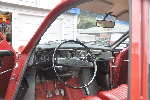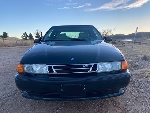
1985-1998 [Subscribe to Daily Digest] |
Hey gang,
Given that so many people have a myriad of problems figuring out base boost, I thought I'd try my hand at an Ari-style base boost troubleshooting checklist. I got the idea from Norm's post in the archives but fleshed it out using everything I've learned here and otherwise. Let me know if you have any suggestions.
Base Boost Troubleshooting Guide (in excruciating detail)
Base boost is a "safe" condition in which the engine will not boost past mid-yellow on the stock boost gauge, even under wide open throttle.
1. Take a test drive (carefully) with your W hose unplugged. After making sure that the W (wastegate) hose is connected to the wastegate actuator (a metal disk shaped object), disconnect the W hose from the BPC valve and go for a brief but careful drive. If your boost levels go past base boost, your problem is electrical - go to #2. If you still don't get anything past base boost, go to #7.
2. Check your APC system fuse. Make sure it's a 10A fuse! If it's blown, replace it, and check #3 and #4.
3. Check your BPC valve. Checking it properly consists of two types of checks: electrical and mechanical. First, with the valve plugged in, listen closely with key on and ignition off to hear if the valve is buzzing. If not, the valve is almost certainly bad and will need replacement.
Using your ohmmeter, test the resistance from pins 1 to 2 and 2 to 3. You should get anywhere from 2 to 3 ohms - usually about 2.5 with newer valves, and closer to 3.0 or slightly higher with OEM valves. If you get an open circuit or massive resistance in either coil, then your BPC valve is faulty and needs to be replaced. If one of the coils in your BPC valve is blown, you may want to check #4 below, as a faulty ECU transistor has been known to quickly ruin new BPC valves by providing a flat 14V current rather than pulses as it normally would.
If the valve checks out electrically, perform a "blow test." Unplug the BPC valve's hoses, being careful to note which ones are which. (Some OEM hoses are marked with the letter of their origin, but others are not.) Blowing air into the C (compression) arm of the valve should push air out of the W (wastegate) arm, but not the lowest R (reference) arm. Likewise, blowing air into the R arm should push air out of the W arm.
If either of these doesn't seem to work, but the valve checks out electrically, cleaning the valve may solve the problem. Spray into the arms of the valve with small amounts of carb cleaner (but nothing silicone-based, as this will ruin your oxygen sensor). Spray the carb cleaner out with light bursts of compressed air (a can from Office Depot will do just fine). Repeat until the valve drips out clean.
4. Check the output from your ECU. Using an ohmmeter, test the resistance from the pins of the cable connected to the ECU to battery ground. Pin 1 and pin 3 to ground should produce resistance ideally from .5 to 2Mohm, but can be slightly lower. An open circuit or significantly lower resistance may be a sign that one or more of the three BPC transistors in the ECU has been blown, and will require either ECU replacement or transistor replacement.
Measure the voltage from pin 2 to battery ground with key on and ignition off. You should be getting ambient voltage - about 12V. With the engine on, this should be producing around 14V. If you aren't getting voltage from this pin, the ECU likely needs to be repaired.
For a more conclusive test, you'll need to remove the ECU from the car. Unplug your battery, and undo the 8mm bolts holding the aquarium cover on. The ECU is the aluminum box in front of the driver's side on US cars. Unscrew the T25 screw holding the ground cable on (DO NOT cut it) and unhook the ECU from the wire harness connector. Using an ohmmeter, test for a short circuit (infinite resistance) from pins 25 to 2 and from pins 25 to 26. If a short circuit appears in either of these tests, the ECU is faulty, and you'll need to replace it or replace the transistors. A guide to replacing the transistors is available in full detail elsewhere on the Internet.
5. Check your cruise control system. Usually, if the cruise control system works competently, then it shouldn't be interfering with the ECU. However, if the cruise control believes itself to be on when it's not, it will limit boost to base levels. However, especially on 1992-94 cars, which have been known to have dodgy "always on" or simply faulty cruise control modules, this is a great place to check.
The easiest way to do this in 92-94 cars, which don't have cruise control integrated into the ECU, is simply to unplug your cruise control module and test drive the car. The module is held in by a clip above the driver's footwell, and you'll need to remove the felt trim covering to get to it. If you get full boost with the module unplugged, then the problem lies within the system, but not necessarily the module. Troubleshooting the cruise control system is an in depth subject all its own, but one important thing that can be checked are the pedal switches.
The two pedal switches are located under the clutch and brake pedals, respectively - naturally, an automatic transmission has only one. First, check them visually from breakage - they tend to have broken plastic tabs which makes them malfunction. Using an ohmmeter, test the voltage coming from Pins 5 and 9 of the cruise control module connector while pressing each of the pedal switches. Each should produce 12V at their respective pins with key on and ignition off. If they produce voltage as normal, the module is likely at fault. (*Does anyone know which one is which?)
6. Check your brake lights and reverse light. Using the help of a trusty friend, make sure your brake lights turn on when you're pressing the brake pedal, and off when you're not. Likewise, make sure your reverse light turns on when in reverse and off when you're not. If the brake lights stay on, you'll need to replace the brake light switch under the brake pedal. (*I require more detail on this. Is there an easy voltage check like the pedal switches? Isn't the reverse switch near the transmission linkage? Has an always-on reverse light been known to occur?)
7. Check your wastegate rod. From under the car, make sure that the wastegate actuating rod is connected to the wastegate actuator - the cotter pin holding it on has a tendency to fall off, or rust into oblivion in Northern states. This is the most likely cause of base boost with the wastegate hose disconnected.
8. Check operation of the one-way PCV valve. First, make sure it's connected to the valve cover - every now and then they will push themselves off. Make sure that you can blow air only in the direction of the intake manifold correction, and not towards the valve cover end of the connection. If it blows both ways, replace the valve.
9. Check your spark plugs. Your spark plugs should only be NGK BCPR7ES, gapped to 0.9 to 1.0 mm. If they're not, or if you think they're getting a bit old, replace them. These are important, as the engine uses the spark plugs themselves as resistors to monitor for knock.
10. Make sure you're using good, premium fuel. This should perhaps go before checking anything else mechanical. Using poor quality fuel can produce knock, which will make the ECU limit your boost anyway.
11. Check for vacuum leaks. This is time-consuming, but can ultimately be worth it. Check all the vacuum hoses in the engine bay for loose connections or cracks, and replace them with sturdy silicone hose if need be. Usually the hoses from the turbocharger to the BPC aren't compromised, as these are silicone themselves, but check them anyway.
* Feel free to add anything you think is pertinent. I tried to be as exhaustive as possible. Thanks to Ari, BobS, Bill Davies, Bill U., Bill Homer, JimO, oldsaab, Norm, & seb, Dillemma and SaabAero at ECU Project, and anyone else I may have forgot for providing in depth information about this.
posted by 136.142.14...
 , Tue, 18 Nov 2008 14:03:41
, Tue, 18 Nov 2008 14:03:41 , Tue, 18 Nov 2008 14:36:42
, Tue, 18 Nov 2008 14:36:42
No Site Registration is Required to Post - Site Membership is optional (Member Features List), but helps to keep the site online
for all Saabers. If the site helps you, please consider helping the site by becoming a member.
 |
 |
 |
 |
 |



